Four Distinct Models Form Lineup for Local EV Company
As the electric vehicle market grows and matures, we are seeing more attempts to differentiate EVs and build identities for models and brands. Exhibit A today comes from an all-day drive program from Lucid Motors—a stair step tour through the four Air models.
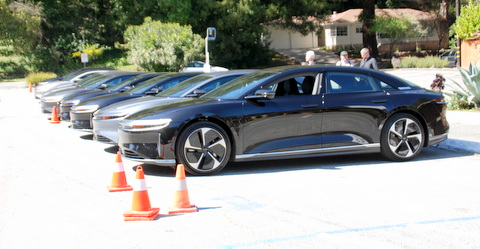
The challenge of a new company with what appears to be one product is differentiation. The Air models look very similar, but the range of performance is as variable as their prices, which builds from $69,900 to $249,000. Clean Fleet Report has had some seat time in the individual models, but this was the first time to experience them back-to-back.
I was able to experience the four models—Pure, Touring, Grand Touring and Sapphire—in sequence. By the end of the day, almost 200 miles later, I became convinced that that Lucid, headquartered just across the San Francisco Bay from where we did the drive, was on to something. Each model has its niche and substance aligned with its price point. Here’s the differentiation detail.
The Basics
As mentioned, all of the Air models are dimensionally similar—four-door sedans with a sleek, aerodynamic silhouette. They’re midsize cars based on the exterior, but have full-size interior space, large trunks and handy frunks (front storage space). All Airs sit on a 116.5-inch wheelbase and have an overall length of 197 inches, virtually identical to the Tesla Model S and significantly smaller than the Mercedes-Benz EQS.

The Air is a full-size luxury sedan based on interior volume and lives up to that description at every trim level. The back seat in particular is spacious and has legroom that suggests the car will serve as a chauffeur-driven model in some markets. That would be a shame because we found all four trims offered a superb driver’s car.
The 2024 models feature the first major changes since the Air was introduced in 2021, but as seems to be the trend in EVs, the changes are more technical tweaks than visible xx.
Pure—Who Could Ask for Anything More

I’m not sure what I was expecting when I got behind the wheel of the entry-level (Pure) Air, but I got out of the car after about 40 miles of curvaceous mountain roads and some pleasant ocean front driving and said—“What more do you need?” The $70,000 Pure has a single permanent-magnet electric motor drive the rear wheels. It’s calibrated to 430 horsepower and 406 foot-pounds of torque, all of it very useful to apply passing laggards out on the road. Handling is crisp, responsive and effortless. More than 400 miles of range from the 88 kWh battery means long drives are welcomed.
Oh, and it’s the most efficient car on four wheels. Lucid just announced the 2025 model hit 5.0 miles per kilowatt-hour of energy and a record 146 MPGe EPA rating. Adding the heat pump from the top-of-the-line Sapphire improved the range (now 420 miles) while boosting the car’s efficiency into unheard-of realms.
The car looks the car of a luxury sedan with its wide, low-slung look. The contour has the cues of luxury—sleek lines, high-tech lighting and tight fit-and-finish..
The 34-inch dash display is perfectly placed with a tablet-sized additional panel in the console. It feels luxurious as you might expect a car in this price to be. Backseat passengers can find all kinds of amenities and more than enough room to spread out Up front, the Air takes the frunk concepts to new heights for a sedan by providing 10 cubic feet of storage.
Touring—A Real Step Up
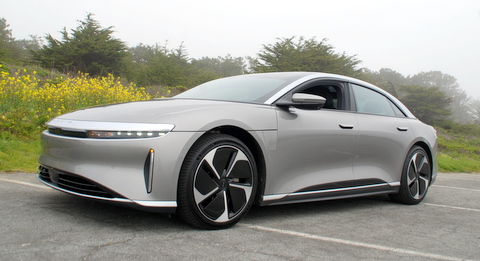
Forget what I just said. You do need more. Specifically more horsepower and torque and all-wheel drive. The Touring, for $8,000 more than the pure, has just what you need. The seat grabs you as you settle in, a foreshadowing that this ride is going to be a bit more than the last one. Never underestimate what 190 more horsepower and 479 more foot-pounds of torque can deliver. Sure, you could pass slower cars in the Prue, but the Touring makes passing feel like you’re driving in a different world. The huge instant torque gets applied immediately—and for as long as you want.
Inside, the Touring model I drove (some of these features are options, but not all available on the Pure), evinced even more luxury trappings than the nicely appointed Pure. Fabric covered the dash and door panels. While settling into the perfectly comfortable and supportive seats, I was struck by the openness of the cabin. The Glass Canopy roof wraps from the windshield in two panels across what was a solid panel in the Pure. Even in the California sun, the massive amount of glass did not transmit that much heat, although strong sunglasses are recommended.
Grand Touring
Now I was really conflicted. The Pure was great until trumped by the superlative power and slightly beefier suspension in the Touring. What more could Lucid add to what seemed to me to be an all-encompassing package?
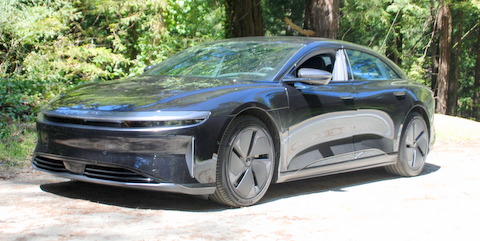
It turns out more is more. Grand Touring takes the excellent Touring trim set up and dials things up. The numbers get big! Almost 200 more horsepower and the longest range of any EV on the market—516 miles (100 more than the Touring or Pure). On top of that, faster charging. All Lucid Air models are built on a high-voltage architecture that enables fast-charging, but the Grand Touring can add 200 miles of range in 12 minutes on a 350 kW DC fast-charger.
The steering feel is lighter with all of that horsepower and torque on tap, but it offers the same lightning responsiveness found in the Touring. Lucid spokesfolks said the Grand Touring had “roughly the same suspension” as the Touring model, but there seemed to be subtle differences taking it over the same course. On top of the performance hardware, the luxury touches get another bump up. The price also takes a big hike to $109,900, which puts it up in Mercedes EQS territory. It can run wheel-to-wheel with a top-end Mercedes, but of course lacks the history, dealer network and falls a little short of the German company’s well-refined sense of luxury.
Sapphire
As it should be, we’ve saved the best for last. The Air Sapphire is the pinnacle of Lucid’s current lineup, clocking in at a stratospheric price tag of $249,000 for the limited production run. The differentiation from the “lesser” Air models is subtle, but telling. Unique wheels and paint colors are the most noticeable distinguishing features, but it’s underneath where the Sapphire demonstrates its value.
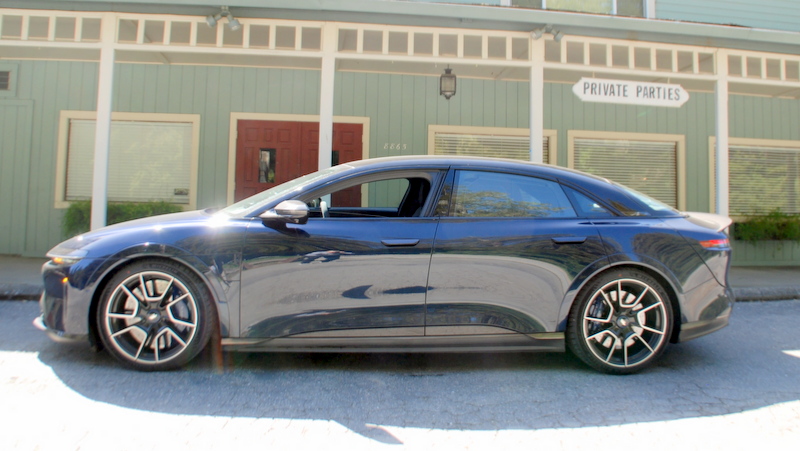
Start with three motors (two rear and one front), cranking out 1,234 horsepower. An aero package helps keep that power to the ground, along with traction control, producing sub-two-second 0-to-60 mph times. I didn’t have a straight stretch of road to test that, but I have no doubt. Even with all that power (if you keep it under control), you can travel 427 miles on the Sapphire’s big battery pack (shared with the Grand touring).
The suspension may be tuned for the track (it does have a track mode that Lucid’s minders directed us not to engage), but on-road it presented itself like a daily driver. A really refined and fast daily driver. I would characterize the Sapphire as a different kind of “self-driving car,” one that feels like it knows the road thanks to torque vectoring controlled by the dual rear-drive motors that basically pivot the rear of the car in turns. Steering, acceleration and deceleration all become effortless as the Sapphire devours the twists and turns of the mountain road. I didn’t have much time in the Sapphire, but I found no practical limits to its capabilities.
Summing It Up
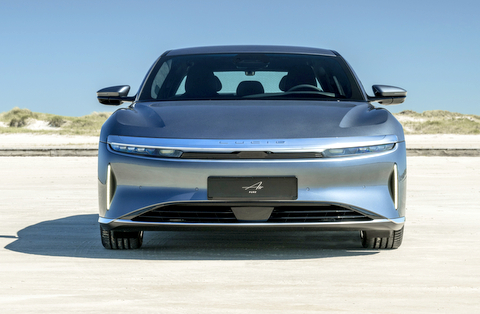
It’s a rare treat to be able to compare cars back-to-back in a setting designed to showcase all of what we expect in a luxury EV. It’s a treat to be able to work through a line-up of sedans on roads designed to showcase their strengths and tease out any weaknesses. The Lucid Air lineup is a rarity in the EV world—a well-thought-out, clearly differentiated series of trim levels that give the buyer distinctive advantages at each stop. I’ll reiterate where I started. The entry-level Air Pure is enough car to more than satisfy anyone in search of an affordable luxury EV sedan. But each step up the Air hierarchy brings significant rewards for the additional cost. There are no losers here. The question is, how much winning can you afford?
Story by Michael Coates. Photos by Michael Coates and Lucid.
Make sure to opt-in to the Clean Fleet Report newsletter (top right of page) to be notified of all new stories and vehicle reviews.
Disclosure:
Clean Fleet Report is loaned free test vehicles from automakers to evaluate, typically for a week at a time. Our road tests are based on this one-week drive of a new vehicle. Because of this we don’t address issues such as long-term reliability or total cost of ownership. In addition, we are often invited to manufacturer events highlighting new vehicles or technology. As part of these events we may be offered free transportation, lodging or meals. We do our best to present our unvarnished evaluations of vehicles and news irrespective of these inducements.
Our focus is on vehicles that offer the best fuel economy in their class, which leads us to emphasize electric cars, plug-in hybrids, hybrids and diesels. We also feature those efficient gas-powered vehicles that are among the top mpg vehicles in their class. In addition, we aim to offer reviews and news on advanced technology and the alternative fuel vehicle market. We welcome any feedback from vehicle owners and are dedicated to providing a forum for alternative viewpoints. Please let us know your views at publisher@cleanfleetreport.com.
